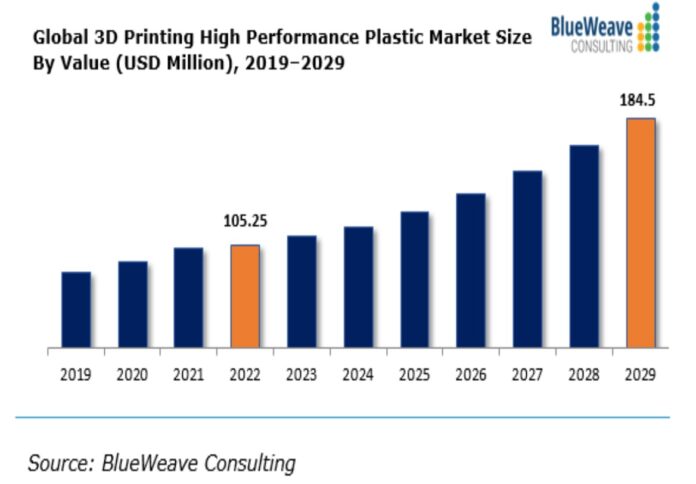
The market for high-performance plastics used in 3D printing is expected to expand significantly between 2023 and 2029, with a compound annual growth rate (CAGR) of 8.45 per cent, reaching a value of USD 184.5 million by that year, according to market research firm BlueWeave Consulting.
This development is attributed to rising demand from end-user industries like automotive, medical, aerospace, and defence, as well as widespread product adoption in the manufacturing industry.
According to the report, increased government initiatives include more financing for research, laws that support 3D printing, and increased focus on environmental deterioration in developing nations.
A significant market driver is the growing usage of 3D printing high-performance plastic in the manufacturing industry, and the stronger components in the goods are balanced by the 3D-printed plastic’s strong-to-weight ratio, the report stated.
Results showed that the global market for high-performance plastics for 3D printing is anticipated to be dominated by the polyamide type segment during the projected period.
Medical professionals use polyamide 3D printers to make medical equipment, and the substance includes a polymer that improves functioning and may be printed on using a variety of techniques.
The study found that 3D printers can create a variety of objects using polymer, including surgical instruments, tissues for use in research, and other medical packages.
Major players operating in the global 3D printing high-performance plastic market include Arkema, DSM, Stratasys, Ltd., 3D Systems, Inc., EOS, Evonik Industries AG, Victrex plc., Solvay, Oxford Performance Materials, SABIC, ENVISIONTEC INC., HP Development Company, L.P., PolyOne Corporation, BASF SE, Filament 3D Printing, 3DXTECH, DuPont, Lehmann & Voss &Co. KG, TORAY INDUSTRIES, INC., and TreeD Filaments.
Meanwhile, the pandemic has had an impact on the market growth for high-performance plastics used in 3D printing, noted the consulting firm.
National and regional lockdowns caused losses to manufacturing facilities, and the report showed that demand in the aerospace, defence, and automobile sectors was hurt by this manufacturing delay.
Nonetheless, throughout the projection period, the report reflected a projected rise in the demand for high-performance polymers for 3D printing, which will increase market revenue.




















